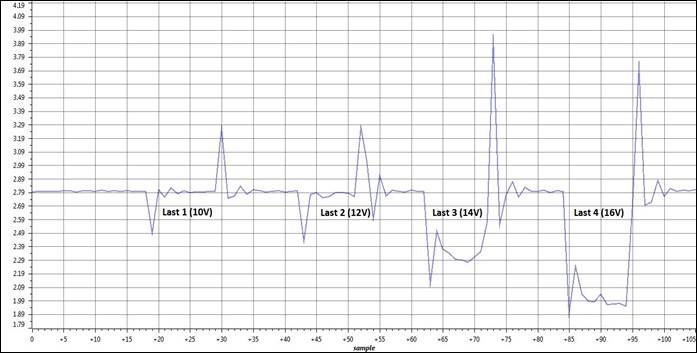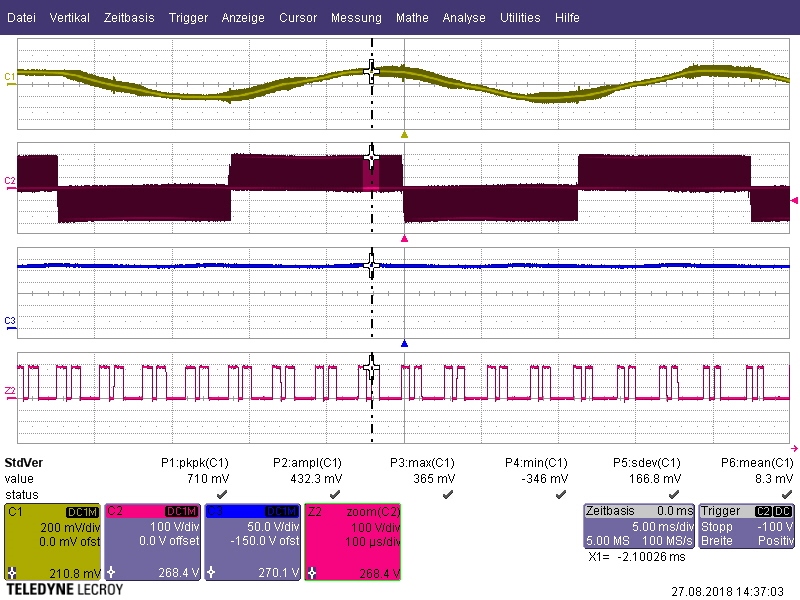Other Parts Discussed in Thread: MOTORWARE, , TMDSHVMTRINSPIN
Hi all,
I need your help with a motor controller using the TMS320F28069F processor (3 year old design). With a simple engine test bench (ACIM engine, 2-pole, 0.55W) with the HVKit (TMDSHVMTRINSPIN & TMDSCNCD28069MISO) experiments have been performed with the InstaSPIN_UNIVERSAL tool (Lab02b-MotorID & Lab11a project). The latest MotorWare version 1.01.00.18 is used.
There are the following problems (detailed documents are also available):
- The determined motor parameters (Lab02b) differ depending on the set PWM frequency.
|
|
TI-High-Voltage-Motor-Control-Kit mit mit ACIM-Motor (2pin, 0.55W) InstaSPIN_F2806xM_UNIVERSAL (proj_lab02b) |
|||
|
PWM-Frequency |
USER_MOTOR_ Rr (Ω) |
USER_MOTOR_ Rs (Ω) |
USER_MOTOR_ Ls_d (H) |
USER_MOTOR_ MAGNETIZING_CURRENT (A) |
|
12kHz |
3.8303122 |
4.0975060 |
0.0068570803 |
2.1514337 |
|
16kHz |
3.7165627 |
4.4100050 |
0.014940408 |
2.0349829 |
|
18kHz |
2.4062523 |
4.4462552 |
0.055235102 |
2.1070599 |
|
20kHz |
1.9003125 |
4.0425057 |
0.065108276 |
2.1640532 |
|
24kHz |
1.3662508 |
3.6949999 |
0.068892903 |
2.5442357 |
- When the PowerWarp (EPL) is deactivated, the speed is not reached and the motor stops. The application (Lab11a / 18kHz) has to be reloaded.
-
With the example project (Lab11a / 18kHz), the speed drops at a load of more than 0.3kW.
Invertek-P2-Frequency converter
Optidrive P2 ODP-2-22220-1KF42-SN (Vectorcontrol/16kHz)
TI-High-Voltage-Motor-Control-Kit
InstaSPIN_F2806xM_UNIVERSAL (proj_lab11a/18kHz)
Braking load
Engine power
Engine current
Intermediate circuit voltage
Rotor speed
Torque
Engine current
Intermediate circuit voltage
Rotor speed
0 (0V)
0.04W
1.4A
310V
2797rpm
0.08Nm
0.44A
306V
2803rpm
1 (10V)
0.16W
1.4A
298V
2787rpm
0.52Nm
0.85A
291V
2800rpm
2 (12V)
0.24W
1.4A
292V
2778rpm
0.76Nm
0.90A
287V
2790rpm
3 (14V)
0.33W
1.5A
285V
2761rpm
1.17Nm
1.35A
278V
2403rpm
4 (16V)
0.45W
1.7A
276V
2738rpm
1.52Nm
1.70A
270V
1903rpm
5 (18V)
0.58W
2.1A
267V
2705rpm
6 (20V)
0.72W
2.5A
258V
2650rpm
Thanks for your help and kind regards,
Miriam









